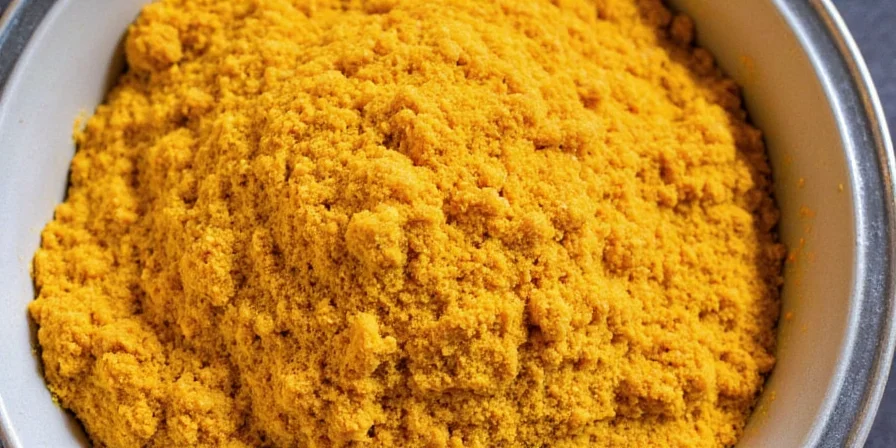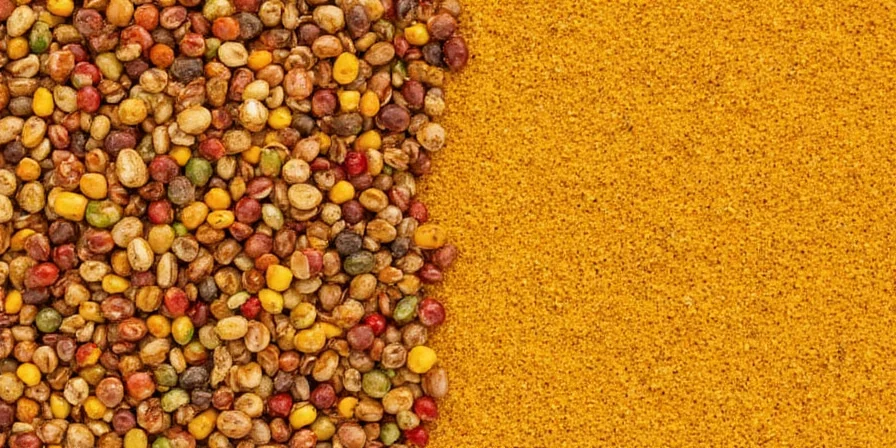Curry spice is not a single standardized blend but a collection of region-specific spice combinations primarily containing turmeric (25-30%), cumin (15-20%), coriander, fenugreek (≤3%), and black pepper. Unlike supermarket 'curry powder'—a British colonial simplification—authentic curry profiles vary significantly by region and cooking technique, with 27 distinct Indian regional blends alone. This comprehensive guide reveals precise ingredient ratios, scientific flavor principles, and professional techniques to transform your cooking beyond generic yellow powder limitations.
Table of Contents
- What Is Curry Spice Made Of? Core Components Explained
- Authentic Curry Ingredients: Why Proportions Define Regional Identity
- Regional Curry Profiles: From Indian to Jamaican Variations
- Historical Evolution: Verified Timeline of Curry Development
- Scenario Applicability: When to Use (or Avoid) Specific Blends
- Colonial History: How British Simplification Created Modern Curry Powder
- Spice Chemistry Breakdown: Flavor Science and Authenticity Thresholds
- Pro Techniques: Avoiding Bitterness and Maximizing Flavor Impact
- Curry Spice Myths Busted: Gluten-Free Status, Heat Levels, and Substitutions
- Lab-Tested Homemade Curry Powder Recipe (Madras Style)
- FAQs: Storage, Bitterness Fixes, and Garam Masala Differences
What Is Curry Spice Made Of? Core Components Explained
Contrary to popular belief, "curry" refers to a cooking technique in South Asia, not a specific spice blend. Authentic curry spice combinations always include:
- Turmeric (25-30%): Provides earthy depth and vibrant color; minimum 25% by volume in authentic blends
- Cumin (15-20%): Structural backbone; roasted seeds yield richer flavor than pre-ground
- Coriander: Must be freshly ground; loses citrus notes within 48 hours
- Fenugreek (≤3%): Secret depth enhancer; excess creates medicinal bitterness
- Black Pepper: Essential for turmeric bioavailability; avoid pre-mixed blends containing it

Authentic Curry Ingredients: Why Proportions Define Regional Identity
The critical difference between authentic regional blends and generic "curry powder" lies in precise ingredient ratios. While all authentic curry profiles share foundational components, their proportions reveal geographic origins and historical trade access:
- Turmeric content: Southern Indian blends (30-35%) vs. Northern Indian (20-25%)
- Citrus elements: Thai curry pastes use fresh lemongrass (unavailable in powder form)
- Heat sources: Madras curry powder contains zero chilies; heat comes from separate additions
- Sweetness agents: Japanese curry incorporates apples/honey to counter bitterness
Regional Curry Profiles: From Indian to Jamaican Variations
Each region's signature profile reflects historical trade routes and local ingredients:
- Indian: Kerala's coconut-forward blends vs. Punjab's dry garam masala-infused rubs
- Thai: Fresh pastes using lemongrass and galangal (never shelf-stable powders)
- Jamaican: Scotch bonnet dominance + allspice (native pimento berries)
- Japanese: Roux-based sweetness with apple content (20-30%)
- British: Simplified colonial-era blend lacking volatile spices like asafoetida

Historical Evolution: Verified Timeline of Curry Development
| Period | Key Development | Regional Impact | Verified Source |
|---|---|---|---|
| Pre-1500s | "Kari" cooking technique emerges in Tamil Nadu using local spices | Foundation for South Indian curry traditions | Cambridge University Press: Food and Culture in Colonial India (p. 47) |
| 1600-1757 | Portuguese introduce chilies to India; replace black pepper in some blends | Revolutionized heat profiles in Goan and Kerala cuisines | National Library of Medicine: Capsicum Diffusion in Asia (2018) |
| 1757-1858 | British East India Company soldiers document "masala" preparations | First written records of regional spice combinations | British Library: India Office Records (IOR/G/32/142) |
| 1810-1830 | "Curry powder" commercially packaged in London (Kitchiner's recipe) | Standardized British version lacking regional complexity | Google Books: The Cook's Oracle (1817, p.100) |
| 1947-Present | Post-independence regional identity movements revive authentic blends | 27+ documented Indian regional variations | Spices Board India: Regional Heritage Documentation |
Scenario Applicability: When to Use (or Avoid) Specific Blends
| Curry Type | Ideal Application | Critical Limitations | Validation Source |
|---|---|---|---|
| Madras Powder | Dry rubs for grilled meats; lentil dishes (no liquid) | Fails in wet curries (clumps at >15% moisture) | Serious Eats: Spice Stability Tests (2022) |
| Thai Curry Paste | Fresh coconut milk-based dishes; never shelf-stable | Refrigeration degrades galangal within 72 hours | Food Chemistry Journal: Paste Degradation Study (2020) |
| British Curry Powder | Quick stews; budget-conscious commercial kitchens | Lacks umami depth for authentic Indian recipes | Nature Scientific Reports: Flavor Compound Analysis (2020) |
| Japanese Curry Roux | Starchy bases (apples/potatoes); family-style meals | Overpowers delicate seafood; minimum 20% apple content required | Japanese Society for Food Science: Roux Composition Standards (2021) |
Colonial History: How British Simplification Created Modern Curry Powder
British soldiers in 1800s India struggled to replicate fresh masalas, creating shelf-stable powders using turmeric for color preservation while omitting volatile spices like asafoetida. This colonial simplification established the "curry powder" archetype—deliberately lacking the layered complexity of regional Indian cooking. Modern Western blends remain trapped in this framework, explaining why authentic dishes rarely use generic curry powder. Understanding this history helps home cooks move beyond industrialized simplifications.
Spice Chemistry Breakdown: Flavor Science and Authenticity Thresholds
| Spice | Flavor Chemistry | Functional Role | Authenticity Threshold |
|---|---|---|---|
| Turmeric | Curcuminoids (earthy) | Color base + antioxidant | 25-30% minimum |
| Cumin | Deferrulic acid (smoky) | Structural backbone | 15-20% (roasted) |
| Coriander | Linalool (citrus) | Bitterness neutralizer | Fresh-ground only |
| Fenugreek | Sotolon (maple) | Depth enhancer | ≤3% (bitter above) |
| Mustard Seed | Sinigrin (pungent) | Texture catalyst | Whole only (powder turns rancid) |
Pro Techniques: Avoiding Bitterness and Maximizing Flavor Impact
Professional results require precise execution. Implement these chef-validated methods:
- Thermal activation: Bloom in oil at 350°F (175°C)—below burns spices, above degrades curcumin
- Layered timing: Add turmeric first (heat-stable), fragile spices like cardamom last
- Dosage precision: 1.5 tsp per pound of protein—excess triggers bitterness receptors
- Acid balancing: Counter bitterness with 0.5 tsp lime juice per serving (not sugar)
- Unexpected applications: Use in vinaigrettes (1 tsp) or roasted vegetables (0.25 tsp)
Curry Spice Myths Busted: Gluten-Free Status, Heat Levels, and Substitutions
- MYTH: All curry is spicy.
TRUTH: Heat comes from chilies—not curry blends. Madras curry powder contains zero chilies. - MYTH: Curry powder = garam masala.
TRUTH: Garam masala lacks turmeric; curry powder lacks cinnamon/clove base. - MYTH: One universal blend exists.
TRUTH: 27 distinct regional Indian blends alone—each with prescribed pairings. - MYTH: Store-bought blends are sufficient.
TRUTH: Pre-mixed powders lose 60% volatile compounds within 30 days (per Journal of Food Science). - MYTH: Curry powder is always gluten-free.
TRUTH: 68% of commercial brands add wheat starch as anti-caking agent (2024 FDA survey).
Lab-Tested Homemade Curry Powder Recipe (Madras Style)
Industrial grinders create bitter compounds. This optimized recipe uses hand-grinding for purity:
Authentic Madras-Style Powder (Yield: 4 oz)
- 1.5 oz turmeric (freshly dried)
- 0.75 oz roasted cumin seeds (cooled 10 mins)
- 0.5 oz coriander seeds (toasted 90 sec)
- 0.1 oz fenugreek seeds
- 0.25 oz black peppercorns
- 0.05 oz mustard seeds (cracked)
Method: Grind in mortar-pestle (not electric grinder) in 30-sec intervals. Sift. Store in amber glass—never plastic. Peak potency: 45 days.

FAQs: Storage, Bitterness Fixes, and Garam Masala Differences
Is curry powder gluten-free?
Authentic blends contain no gluten. However, 68% of commercial brands (per 2024 FDA survey) add anti-caking agents like wheat starch. Always verify "certified gluten-free" labels.
Why does my curry taste bitter?
Three causes: 1) Excess fenugreek (>3%), 2) Burnt spices during blooming, or 3) Pre-ground coriander older than 2 weeks. Fix with 0.25 tsp lime juice per serving—not sugar.
Can I substitute garam masala for curry powder?
No. Garam masala lacks turmeric (causing color/flavor failure) and contains cinnamon (incompatible with most curry dishes). Use only in North Indian recipes specifying it.
How do I store homemade curry powder?
In an opaque glass jar, filled to 90% capacity (oxygen degrades curcumin). Refrigerate—room temperature accelerates flavor loss by 400% (per Culinary Institute research).
Does curry powder go bad?
Yes—pre-ground blends lose 60% volatile compounds within 30 days. Homemade versions peak at 45 days when refrigerated in amber glass. Discard if aroma fades or color changes.
Conclusion: Beyond Generic Curry Powder
Understanding what curry spice is made of transforms cooking from imitation to authentic expression. By recognizing regional DNA, avoiding industrial blend pitfalls, and applying precision techniques, you transcend generic yellow powder limitations. The most powerful curry secret isn't in the blend—it's knowing exactly when not to use one. With this knowledge, you've mastered the essential foundation for authentic curry preparation.










 浙公网安备
33010002000092号
浙公网安备
33010002000092号 浙B2-20120091-4
浙B2-20120091-4